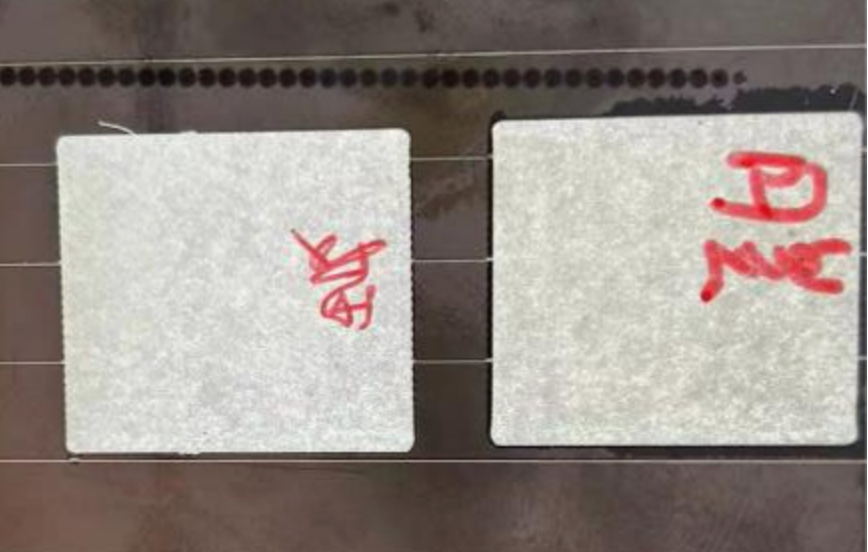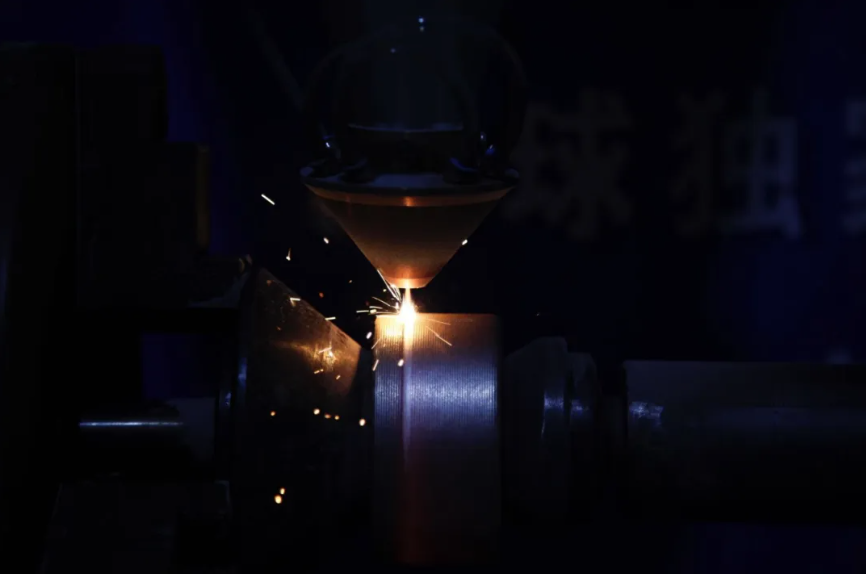Raycus master P1000H Laser Calcium Titanite Clear Edge Efficiently Reaches User Requirements
Photovoltaic power generation is based on the principle of photovoltaic effect and utilizes solar cells to convert sunlight energy directly into electricity. Chalcogenide material is a semiconductor material with a special crystal structure, which is widely used in solar cells. In the preparation process of chalcogenide solar cells, edge clearing is an important step, which helps to remove the excess chalcogenide material at the edge of the cell and avoid the influence of the edge effect on the cell performance. By precisely controlling the edge-clearing process, the structure of the cell can be optimized and the non-radiative composite can be reduced, thus improving the photoelectric conversion efficiency and long-term stability of the cell. In addition, edge clearing helps to improve the appearance quality and overall performance of the cell, making it more reliable and efficient in practical applications. This article mainly provides solutions for the application of Raycus's flagship P1000H laser in chalcogenide edge clearing, to provide customers with references in practical process applications.
Advantages of Laser Edge Clearing Technology
Compared with the traditional way of clearing the edges of calcite cells, which usually adopts the chemical wet etching method, there are many problems such as the etchant may cause damage to other parts of the cell, and the complexity of cleaning, etc., laser edge clearing has a number of significant advantages, which makes it an ideal alternative to the traditional method. The main advantages of laser edge clearing are as follows:
1. High efficiency, high precision: one of the difficulties in the industrialization of chalcogenide from a small area of the cell to a large area of the efficiency loss of the component, the processing of thermal control, and precision requirements are demanding. The laser edge clearing technology can accurately control the width and depth of the edge clearing, a better solution to the above difficulties.
2. Low cost: by matching the speed of the assembly line and the relevant parameters of laser cleaning, it can realize large-area, fast, and uniform processing, effectively? Reduced production costs.
3. Flexible applications: chalcogenide materials have good flexibility and bendability, suitable for making flexible optoelectronic devices. Laser edge clearing technology can adapt to different shapes and sizes of the substrate, for the manufacture of flexible photoelectric products to provide convenience.
4. Non-contact: It can effectively avoid substrate stress and cracks that may be caused by mechanical action, thus maintaining the structural integrity of the cell.
5. Strong adaptability: laser scribing technology can be applied to different sizes and shapes of the cell, is adaptable, and can be highly automated in production, improving production efficiency.
6. Green: no need to use chemical etching agent, less impact on the environment, more in line with the requirements of green manufacturing.
Application analysis of Raycus Master P1000H Calcium-Titanium Clear Edge
This case study focuses on the application of Calcium-Titanium clearing with the Raycus-Master P1000H laser. We have tested and compared the two laser solutions for Calcium-Titanium clearing, and adopted the relatively better way to test the effect.
(1) Self-developed and self-produced large mode field gain fiber to achieve 1kW average power, to achieve a single module of 1000W pulsed laser output; (2) the maximum single pulse energy boost to 100mJ; (3) has a strong anti-high-reflective ability, can be vertically out of the light to clean high-reflective materials; (4) the minimum pulse width of up to 20ns, for the field of the thermal effect of the requirements of the field; (5) the BPP is less than 25mm * mrad @ 400 microns.
Can be widely used in the field of photovoltaic calcite clear edge, mold cleaning, ships, aircraft, and other large-scale equipment to remove paint and rust; precision parts of the precise paint removal; surface roughness, hair, etc.; especially in the new energy power battery blue film, blue paint cleaning, and other fields have obvious advantages. And for the photovoltaic fields of calcite clear edge applications generally use square spots, process effect is better.
Compared with the direct irradiation of the calcite film program, the use of laser cleaning through the glass for better results
For calcium titanium ore in the clear edge processing, the first step is to determine the thickness of the substrate surface of the calcite film, for the subsequent cleaning parameters to provide a reference to ensure that the power is too small to lead to residual cleaning, but also will not make the cleaning of the laser power is too large damage to the substrate, the test results are shown in Figure 2 below, the film thickness of about 13 μm.
When clearing the edges of the chalcogenide, it is necessary to determine the optimal direction of laser irradiation, including direct irradiation of the chalcogenide film and through the glass for cleaning two options, the specific comparative test is as follows:
With the same parameters on the front and back surface of the calcite cleaning effect test, as seen in Figure 3, the two cleaning programs can ensure that after processing, the substrate surface calcite has no residue, and no damage to the glass substrate, but the use of the laser directly on the calcite film cleaning, the soot generated will produce a laser blocking, and even to the substrate glass smoked yellow. Therefore, compared with the use of laser cleaning through the glass on the calcite film is more reasonable and more effective.
Raycus P1000H square spot laser calcite edge clearing process with good results, to achieve the customer's requirements
In the actual production process, the glass surface of the calcite conductive film edge clearing method shown in Figure 4 below, in which the laser maintains a line of continuous light, and the position is unchanged, the conveyor belt below to drive the need to clear the edge of the calcite samples moving quickly, the laser scanning speed and platform moving speed to match, you can expand the line into a surface, and quickly complete the calcite edge clearing process.
We use a Raycus P1000H square spot laser, configured with an F170 field mirror, the platform can move at a speed of 115mm / s, the specific cleaning effect is shown in Figure 5 below, the laser cleaning of the glass surface has no chalcogenide plating residue and brighter, the substrate has not been damaged, after the multimeter test, it can be proved that the surface is insulated after the cleaning (Figure 6).
The microscope observes the sample as shown in Figure 7, under the microscope, the square spot edge is obvious internal uniformity, the spot lap state is good and no damage to the substrate, and the surface as a whole is more beautiful. The results of each process are highly efficient to achieve the customer's requirements.
With the transformation and upgrading of various industries, the laser is increasingly widely used in the field of photovoltaic due to its significant advantages. Laser equipment in the preparation of chalcogenide is mainly used for P1, P2, and P3 laser scribing and P4 laser edge clearing. Among them, P1, P2, and P3 laser scribing generally use infrared picoseconds or green light picoseconds and a series of ultra-fast lasers for etching and scribing, Raycus flag series P1000H pulsed lasers are mainly used for P4 chalcocite edge clearing.
Reading more at: https://www.mrj-lasermark.com/info/383244/








Comments
Post a Comment